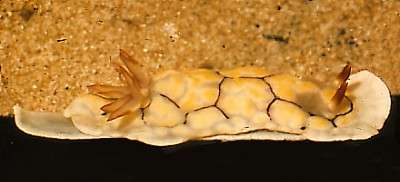
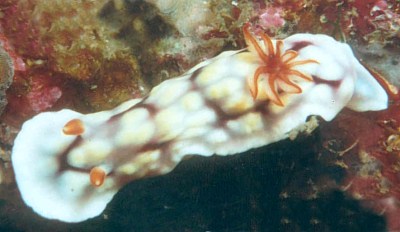
Chromodoris conchyliata
Yonow, 1984
Order: NUDIBRANCHIA
Suborder: DORIDINA
Superfamily: EUDORIDOIDEA
Family: Chromodorididae
DISTRIBUTION
Indian Ocean. (Kenya, Sth Africa, Sri Lanka, Thailand).
PHOTO
UPPER: Diani, seaward of Jadini Reef, Kenya, 2m, July 1970. 38mm long alive. Photo: H.G.Hamilton.
LOWER: Scottburgh, 25m, south coast KwaZulu-Natal,
SOUTH AFRICA, June 2000, Size: 35mm. Photo: Valda Fraser.
This has been considered a sibling species of Chromodoris geometrica from the Western Pacific. That species has greenish gills and rhinophores, although quite pale in some specimens. C. conchyliata from the Indian Ocean is a similarly coloured species in which the gills and rhinophores are lined with red or reddish-orange and the pustules are often quite yellowish. Both species have a deep purple colouring to the ventral surface of the anterior mantle.
It was first reported and illustrated from Kenya (Rudman, 1973) - as Chromodoris cf. geometrica and Nathalie Yonow (1984) described it from Sri Lanka as a new species. However Valda Fraser's message showing that both species occur in South Africa is of great interest.
References:
•Rudman, W.B. (1973) Chromodorid opisthobranch Mollusca from the Indo-West Pacific. Zoological Journal of the Linnean Society 52(3): 175-199.
•Yonow, N. (1984). Doridacean nudibranchs from Sri Lanka, with descriptions of four new species. The Veliger, 26(4): 214-228.
Rudman, W.B., 2000 (April 5) Chromodoris conchyliata Yonow, 1984. [In] Sea Slug Forum. Australian Museum, Sydney. Available from http://www.seaslugforum.net/find/chroconc
Related messages
Chromodoris conchyliata laying eggs
May 8, 2007
From: Hugues Flodrops
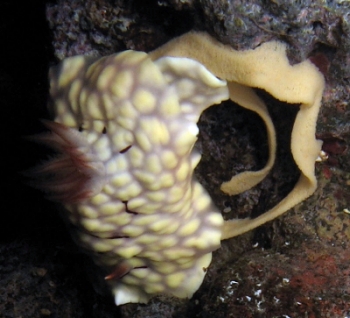
Dear Bill,
In addition to my previous message about feeding observations [#19889], here is one picture of Chromodoris conchyliata laying eggs in the same pool, on another night. Twenty minutes before, there were no eggs so I'm sure that this specimen was laying eggs.
Locality: Etang Salé. Permanent pool, 1 metre, Reunion Island, Indian Ocean, 5 may 2007, Night since two hours. Length: 35 mm. Photographer: Hugues Flodrops.
Best wishes.
Hugues
hugues.flodrops@wanadoo.fr
Flodrops, H., 2007 (May 8) Chromodoris conchyliata laying eggs. [Message in] Sea Slug Forum. Australian Museum, Sydney. Available from http://www.seaslugforum.net/find/19890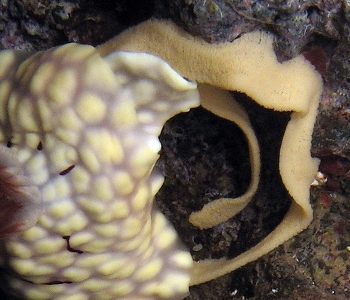
Dear Hugues,
Thanks again for a valuable observation. This is the first information we have on its egg ribbon. As we might expect, it looks quite similar to that of C. geometrica [see message #10872], a common species in the western Pacific, which is very similar in colour pattern and body shape. It also feeds on C. violacea and is probably closely related.
Best wishes,
Bill Rudman
Chromodoris conchyliata feeding observation
May 8, 2007
From: Hugues Flodrops

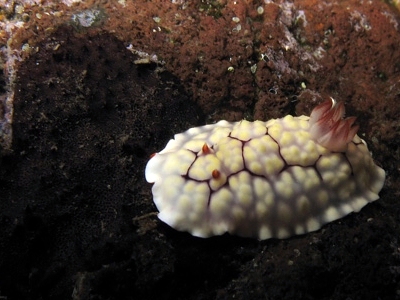
Concerning message #14945:
Dear Bill,
I'm pretty sure that Chromodoris conchyliata is feeding on this purple sponge. I saw three specimen during the night, feeding in different parts of the same pool always on this kind of darwinellid purple sponge.
Is it Chelonaplysilla violacea?
Locality: Etang Salé. Permanent pool, depth between 50 cm and 100 cm, Reunion Island, Indian Ocean, Upper: 5 April 2007, length 20 mm - at night. Middle: 28 April 2007, length 35 mm. Lower: 8 April 2007, length 30 mm. Photo: Hugues Flodrops.
Thanks for your knowledge.
Best regards.
Hugues
hugues.flodrops@wanadoo.fr
Flodrops, H., 2007 (May 8) Chromodoris conchyliata feeding observation. [Message in] Sea Slug Forum. Australian Museum, Sydney. Available from http://www.seaslugforum.net/find/19889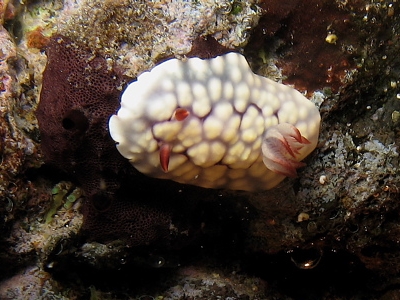
Dear Hugues,
Thanks for this. At the conference in Bonn last year I predicted that this species would feed on Chelonaplysilla violacea and your observations certainly suggest that it does. While finding one animal on this sponge could be considered a coincidence, finding three is pretty convincing - and from looking at the markings on the slugs, they certainly appear to be three different individuals. Apart from being very similar in colour to C.geometrica, which feeds on this sponge, another reason for thinking it would feed on this sponge is that it has a purple patch on the underside of the anterior mantle, and five other species with the same purple patch also feed on this sponge.
Best wishes,
Bill Rudman
Chromodoris conchyliata query feeding on sponge
October 7, 2005
From: Colin Ogden

Hi Bill,
This morning on a dive on our Ribbon reef I found this nudi. At first I thought it was Chromodoris conchyliata, but on downloading it I am not convinced.
Locality: Sodwana Bay, South Africa. IndianOcean coast. Depth: 18 metres
Length: 30 mm. 6 October 2005. Coral reef. Photographer: Colin Ogden
The border to its mantle and the colours exposed under its hood next to its mouth are making me question my ID. Also the full colour on its gills does't look right to be the C. conchyliata. I had a look on the Forum at our previous messages and noted that you were keen to see the sponge it was feeding on. It appers to be feeding in the photos, but conditions were rough and it had just drifted into that position. Would it start feeding within seconds of landing next to its food source, or are its actions a system of just trying to stabilise itself.
Regards
Colin
scubaco@iafrica.com
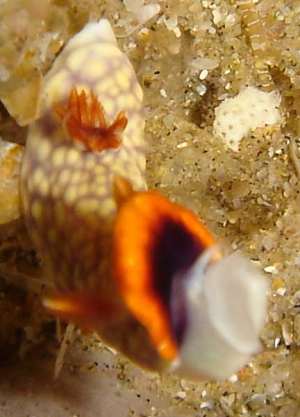
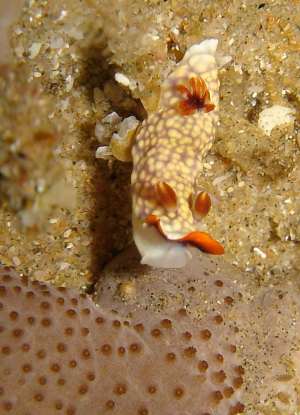
Dear Colin,
I can understand your hesitancy in identifying this as C. conchyliata, but I am sure that's what it is. What it lacks is the thin dark purple network between the pustules on the mantle but that is quite variable. It is nice to get a good photo of the underside of the anterior mantle. We have an earlier photo from Sth Africa from Valda Fraser [#2661] showing the same colour. Some of the other photos on the Forum of the dorsal surface show just a reddish orange bit at the edge. This is one of an interesting group of chromodorids with purple on the anterior underside of the mantle.
When I saw your message I thought - great! Colin's got a feeding record for this species. Don't feel bad, but no it is not feeding. The colony it has landed on is a soft coral not a sponge - and the white rounded bit sticking out the front is the front of the foot. Have a look at the nudibranch head Fact Sheet, and Brian Whorton's message [#14139] which has 3 photos, including two other species with purple undersides, to get an idea of their anatomy. The mouth is right between the two oral tentacles, and that is from where the buccal bulb will extend during feeding. I must say I am in two minds whether the white object we can see in your C. mandapamensis photo [#14931] is the buccal bulb or the front of the foot.
Although its not a feeding record, it is a nice record of a colour variation in this species that we didn't know about.
Best wishes,
Bill Rudman
Chromodoris geometrica & C. conchyliata
June 27, 2005
From: Colin Ogden

Hi Bill,
These photos were taken recently in Sodwana Bay.
Locality: Sodwana Bay, South Africa, Indian Ocean. Depth: 19 to 24 metres. Length: 25 mm. May and June 2005. Coral reef. Photographer: Colin Ogden
I believe the nudi in the upper photo is a Chromodoris conchyliata because of the reddish tinge to gills and rhinopores, and also the yellowish pustules on its back compared to the other 2 nudis which I think are the Chromodoris geometrica. Although these 2 also appear to be slightly different, they do have a black section on their tails just below the "mantle"
Am I correct in my ID.
Regards
Colin
scubaco@iafrica.com


Dear Colin,
You are correct in your identifications. Have a look at Valda Fraser's message [#2570] asking about this very question. When I first reported on C. conchyliata from Kenya in 1973 I thought it was probably a regional colour form of C. geometrica but the information we now have on the Forum, and the existence of both 'forms' in South Africa, suggest they are both good species. The most obvious external difference is the colour of the gills and rhinophores - green-tipped in C. geometrica and orange-tipped in C. conchyliata - but your certainly the black markings on the posterior foot of C. geometrica may also be a good external difference.
As I said to Valda, it would be nice to get photos of their food sponges and egg ribbons.
Best wishes,
Bill Rudman
Chromodoris conchyliata from Burma
June 22, 2005
From: Sergey Parinov

Dear Bill,
This is Chromodoris conchyliata from Mergui Archipelago.
Locality: South Mergui, tiny island/pinnacle close to Thai border, Myanmar [Burma], Indian Ocean, Andaman Sea. February 2004.Upper right, lower left: Depth: 20-25 meters. Length: 3-5 cm. reef slope. Lower right: Depth: 28 meters, Length: 1 cm. flat bottom ~20 meters away from the rocks. Photos: Sergey Parinov.
Sergey Parinov
www.sergeyphoto.com/underwater/nudibranchs
webmaster@sergeyphoto.com
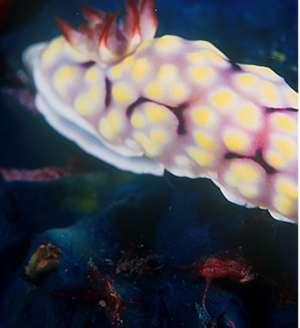
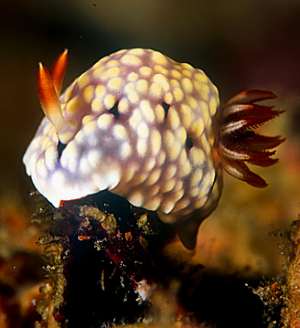
Dear Sergey,
This species seems to be one of group showing a distribution pattern from east Africa right around to Thailand. Another interesting point is the blue sponge both animals are on, although not so clear in the lower photo. I checked earlier messages and found one [message #2203] with a similar blue patch. Not totally convincing evidence, but it matches the similarly coloured C. geometrica which feeds on the bluish Aplysilla violacea. In that species the underside of the anterior mantle is a bright deep purple. In C. conchyliata the underside of the anterior mantle is also coloured purple, but there is often an orange or reddish band along the edge, which can be seen in your upper photo.
Best wishes,
Bill Rudman
Chromodoris conchyliata from Reunion island
February 16, 2005
From: Philibert Bidgrain


Reunion Island sea slugs:
We have find three specimens of Chromodoris conchyliata, the first one was found by Maurice Jay (upper photo) and another specimen (lower photo) was found by Emmanuel Eby at Saint Leu (8 October 2004) (Reunion Island, Indian Ocean):
Best Regards
Philibert Bidgrain
pbidgrain@yahoo.fr
Bidgrain, P., 2005 (Feb 16) Chromodoris conchyliata from Reunion island. [Message in] Sea Slug Forum. Australian Museum, Sydney. Available from http://www.seaslugforum.net/find/12972Thanks Philibert,
Best wishes,
Bill Rudman
Chromodoris conchyliata from the Maldives
March 20, 2003
From: Orhan Aytur

Bill,
Here is a picture of a nudibranch that I took in the Maldives. I think it is Chromodoris conchyliata; could you please verify this?
Date: January 2002
Location: Old Jetty, Dhangethi Island
Ari Atoll, Maldive Islands
Depth: 50cm
Cheers,
Orhan
aytur@ee.bilkent.edu.tr
Aytur, O., 2003 (Mar 20) Chromodoris conchyliata from the Maldives. [Message in] Sea Slug Forum. Australian Museum, Sydney. Available from http://www.seaslugforum.net/find/9369Thanks Orhan,
Yes this is Chromodoris conchyliata.
Best wishes,
Bill Rudman
Chromodoris conchyliata from Myanmar
March 20, 2003
From: Mary Jane Adams

Hi Bill,
I guess this is Chromodoris conchyliata. It looks a little like Chromodoris geometrica but the colors are all wrong. I also photographed a C. geometrica on this dive which was very typical of the species.
Length: 20mm,
Divesite: Black Rock, an islet in the Andaman Sea off the coast of Myanmar.
Date: Feb. 26, 2003.
Best regards,
Mary Jane
divepng@yahoo.com
Adams, M.J., 2003 (Mar 20) Chromodoris conchyliata from Myanmar. [Message in] Sea Slug Forum. Australian Museum, Sydney. Available from http://www.seaslugforum.net/find/9400Dear Mary Jane,
This is Chromodoris conchyliata. Its colour pattern is a nice intermediate between one from the Maldives I am posting today, and a photo from Thailand, with small yellow spots, which I tentatively identified as this species some time ago.
Best wishes,
Bill Rudman
Deformed Chromodoris conchyliata
July 7, 2000
From: Valda Fraser
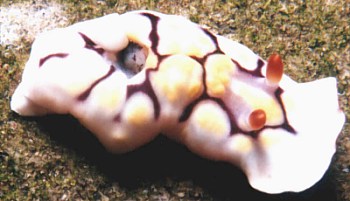
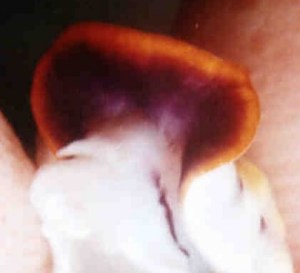
Dear Bill
This is a strange looking one. Where are its gills? I watched it for hours and it seemed very healthy. I took a photo of its underside because I love the colour! The lateral line runs all the way down to the end of the foot.
Locality: Mpande, Transkei, SOUTH AFRICA - intertidal zone
Date: June 2000
Size: 25mm
Thanks.
Valda
iti04937@mweb.co.za
Fraser, V., 2000 (Jul 7) Deformed Chromodoris conchyliata. [Message in] Sea Slug Forum. Australian Museum, Sydney. Available from http://www.seaslugforum.net/find/2661Dear Valda,
Apparently something with sharp teeth decided your chromodorid's gills looked like the feeding tentacles of a juicy 'fan worm'. It seems that some nudibranchs can sustain quite considerable body damage and still survive. They can probably 'breathe' to some extent through their skin, but whether they can also carry on normal physiological activities like growth and digestion, we don't know. Although we know that aeolids can replace lost cerata it would be interesting to know whether dorids can regrow lost parts like gills and rhinophores.
The purplish underside to the anterior part of the mantle is certainly spectacular. As I have discussed elsewhere in the Forum there are a group of chromodorids which have this feature and flaunt it by flapping the anterior mantle up and down as they crawli along [see C. geometrica and C. hintuanensis.
Best wishes,
Bill Rudman.
Chromodoris conchyliata from Thailand
April 6, 2000
From: N. Sittithaweepat

Dear Bill
I can't identify this nudibranch. I found it at Similan Island and photo by Dr. Thon Thamrongnawasawat. I don't record date and depth.
Thank you
Narongpon Sittithaweepat
chromodorid@thaimail.com
Sittithaweepat, N., 2000 (Apr 6) Chromodoris conchyliata from Thailand. [Message in] Sea Slug Forum. Australian Museum, Sydney. Available from http://www.seaslugforum.net/find/2203Dear Narongpon,
This is Chromodoris conchyliata. It is very similar in colour to Chromodoris geometrica which is found in the western Pacific and the Indonesian Archipelago. Chromodoris conchyliata is only known from the Indian Ocean, and until your photo, it was only recorded from the western Indian Ocean. Your find is very interesting because it brings the two species into much closer geographic proximity. It would be interesting to know if both species occurred in Thailand.
The most distinctive difference externally is that in Chromodoris conchyliata the gills and rhinophores are lined with red or reddish-orange and the pustules are often quite yellowish, while in C. geometrica the gills and rhinophores are greenish and the pustules are usually coloured cream. This is an interesting find.
Best wishes,
Bill Rudman.
